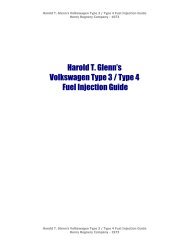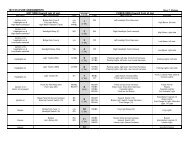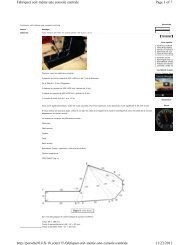D-Jetronic Fuel Injection for the Porsche 914 - Bowlsby.net
D-Jetronic Fuel Injection for the Porsche 914 - Bowlsby.net
D-Jetronic Fuel Injection for the Porsche 914 - Bowlsby.net
You also want an ePaper? Increase the reach of your titles
YUMPU automatically turns print PDFs into web optimized ePapers that Google loves.
D-<strong>Jetronic</strong> <strong>Fuel</strong> <strong>Injection</strong> <strong>for</strong> <strong>the</strong> <strong>Porsche</strong> <strong>914</strong><br />
has been up to pressure <strong>for</strong> awhile,<br />
turn off <strong>the</strong> power to <strong>the</strong> pump.<br />
Check <strong>the</strong> vials at <strong>the</strong> injectors. If<br />
<strong>the</strong>re is any fuel in <strong>the</strong> vials <strong>the</strong>n <strong>the</strong><br />
injector (or injectors) are leaking<br />
and must be replaced. Check <strong>the</strong><br />
pressure gauge again, is it holding<br />
pressure? If not, <strong>the</strong> check valve in<br />
<strong>the</strong> fuel pump is not working, or<br />
one or more of <strong>the</strong> injectors are<br />
leaking.<br />
7) OK, time <strong>for</strong> <strong>the</strong> Injector Flow<br />
Test. Be very careful, as you will<br />
now have four "fuel leaks" in your<br />
engine compartment (that is, if<br />
everything is working). Reinstall<br />
your battery. Disconnect <strong>the</strong> wire<br />
from <strong>the</strong> distributor to <strong>the</strong> coil<br />
(Important - you don't want any<br />
sparks flying around!). With each<br />
injector in its cylinder or vial, floor<br />
your accelerator and crank <strong>the</strong><br />
engine <strong>for</strong> 15 - 20 sec. Now,<br />
carefully remove <strong>the</strong> vials and line<br />
<strong>the</strong>m up on a level surface. The<br />
exact amount is not important (I get<br />
about 7 - 8 cc in 15 sec <strong>for</strong> a 1.7L)<br />
at this point. What we want to see is<br />
<strong>the</strong> same amount <strong>for</strong> each injector<br />
(ideally, up to 10 percent variation<br />
is all right unless you are racing in<br />
which case....optimize). If <strong>the</strong>y look<br />
good, you are done, however, my<br />
experience has been that one or<br />
more injectors are faulty! Most<br />
common is low flow or no flow<br />
(though occasionally <strong>the</strong>re will be<br />
too much). Warning, if <strong>the</strong>re is no<br />
flow <strong>the</strong> problem may be elsewhere<br />
in <strong>the</strong> system. I switch injectors (or<br />
just switch wires) and rerun <strong>the</strong> test,<br />
if <strong>the</strong> problem stays with <strong>the</strong><br />
injector, replace it. You may also<br />
wish to inspect <strong>the</strong> spray pattern of<br />
each injector (certainly if you are<br />
building that auto-cross winner).<br />
The pattern should be cone shaped.<br />
My experience has been that flow<br />
rate is <strong>the</strong> most important<br />
http://www.rennlist.com/techarticles/djetronicfuel.htm<br />
Page 9 of 10<br />
1.7L is bumped up to 1.9L,<br />
however I have found this to be<br />
unnecessary if <strong>the</strong> stock cam is<br />
retained.<br />
First, remove <strong>the</strong> pressure sensor.<br />
You will notice a large plug with a<br />
slot in it sealed with epoxy on <strong>the</strong><br />
end of <strong>the</strong> unit. Heat <strong>the</strong> epoxy (I<br />
use a heat shrink gun but a powerful<br />
hair drier should work) and scrap it<br />
away with a screwdriver. Once <strong>the</strong><br />
slot is clear, turn <strong>the</strong> plug in a bit<br />
and remove <strong>the</strong> epoxy from <strong>the</strong><br />
threads. Continue turning <strong>the</strong> plug<br />
out <strong>the</strong>n in and scrape <strong>the</strong> epoxy<br />
away until you can remove <strong>the</strong><br />
plug. Allow <strong>the</strong> unit to cool. You<br />
will see an adjusting screw inside<br />
<strong>the</strong> pressure sensor.<br />
Mount <strong>the</strong> sensor in <strong>the</strong> car with <strong>the</strong><br />
access hole pointing up so that you<br />
can see <strong>the</strong> adjusting screw.<br />
Turning <strong>the</strong> screw clockwise will<br />
lean out <strong>the</strong> mixture,<br />
counterclockwise will make it<br />
richer. Ideally, use a CO meter or<br />
an O2 (lambda) sensor to set <strong>the</strong><br />
mixture. Set <strong>the</strong> mixture to 2.0 - 2.5<br />
% CO at 2,500 RPM. I use a single<br />
wire O2 sensor mounted on <strong>the</strong><br />
exhaust system on my 1.9L which<br />
gives me <strong>the</strong> instantaneous air/fuel<br />
ratio at all times, even while driving<br />
<strong>the</strong> car.<br />
You can set <strong>the</strong> mixture "by ear" if<br />
you must. Make sure <strong>the</strong> engine is<br />
up to normal operating temperature.<br />
Run it up to 2,500 RPM and hold it<br />
<strong>the</strong>re, adjust mixture <strong>for</strong> <strong>the</strong><br />
smoo<strong>the</strong>st sounding running. This<br />
will set <strong>the</strong> overall mixture. Turn<br />
off <strong>the</strong> engine, install <strong>the</strong> plug and<br />
mount <strong>the</strong> pressure sensor as<br />
normal. Now, to set <strong>the</strong> idle<br />
mixture, try turning <strong>the</strong> adjustment<br />
on <strong>the</strong> top of <strong>the</strong> ECU, clockwise<br />
enriches in this case.<br />
12/18/2007







